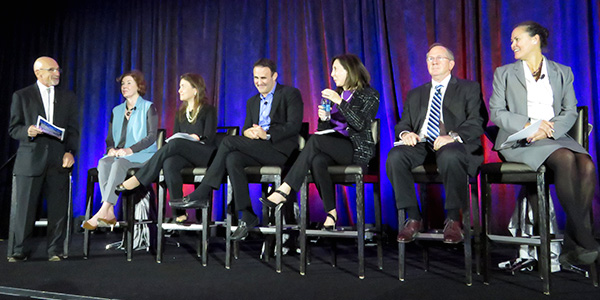By Rich Heidorn Jr.
WASHINGTON — The role of regulators in adapting to new transmission technology was the topic for the opening general session of the Energy Bar Association’s Mid-Year Energy Forum last week, where Mark Jamison gave a history lesson.
Jamison, director of the Public Utility Research Center at the University of Florida, said the telecommunications revolution that followed the breakup of AT&T’s monopoly in 1984 illustrates what he called the “myths” of industry transformations.
“One of those myths is we can … create the future by rearranging the components of the past,” he said. “What happens is when you … start opening things up to competition … the real underlying economics of the system just comes roaring out and it creates a future that we did not anticipate.”
The breakup of AT&T assumed a difference between local telephone service and long-distance service, he said. “Once we opened the markets, we found out that that assumption was fundamentally flawed. The technologies, the customers said, are not distinct from each other.”
Jamison said the electric industry is likely to be upended by technologies such as blockchain and artificial intelligence.
“It could drive us to larger, more expansive utility services, or it could shrink them down further. It all depends upon how the economics actually play out,” he said. “Blockchain would tend to disassemble things; artificial intelligence could put things back together again, make them even bigger. We just don’t know.”
Former FERC Commissioner Nora Mead Brownell also cited blockchain and AI as technologies she is watching. She also is keen on transmission technology.
“We spend time talking about generation mix — candidly perhaps a little too much — and not enough time talking about all the [transmission and distribution] technologies that can add efficiency, add transparency, have applications that solve for multiple problems, like cyber, like customer interaction … and solve for reliability and resiliency,” said Brownell, who serves on the boards of several technology companies in addition to that of U.K.-based utility National Grid.
A Call for Short-term Thinking

Gregg Rotenberg, CEO of Smart Wires, called for less emphasis on long-term transmission planning and more focus on short-term needs. “We’re getting far worse [at predicting the needs of the future grid]. This changeover in generation … is incredibly difficult to predict. And just as much innovation is going on on the consumer side. So, if you can’t tell me where generation is going to be, if you can’t tell me what load is going to be at any one substation, how could a utility possibly predict what their grid needs going forward?” he asked.
“What we’ve really done is built a system that takes three to five years to make the simplest of decisions because we treat every decision as though it is a 30-year investment and that you have 30-year information on what your grid is going to look like, and that’s simply not the world we live in anymore,” Rotenberg said.
Kelly Speakes-Backman, CEO of the Energy Storage Association, said focusing exclusively on the short term is not realistic. “You have to think about long-term investments because these are really large investments.”
“I totally agree,” Rotenberg responded. “When you have to think long term, let the market compete for who’s going to make that long-term investment.”
Changing TOs’ Incentives
Rotenberg said utilities in Europe and Australia have been quicker to adopt advanced transmission technology by his company and others because they have ratemaking rules that allow their utilities to share in savings. In most of the U.S., by contrast, utilities’ rate-of-return structures incent them to spend more on expensive transmission upgrades. Rotenberg said seven of the top 11 utilities in the U.S. have nonetheless adopted his company’s power flow “valves” and should be regarded as “heroes” because the technology will reduce their earnings.
Susan Pope, managing director of FTI Consulting, agreed with Rotenberg on the need for change. “If a battery is the cheapest way to ensure service to a customer at the long end of a transmission line, we shouldn’t be building wires,” she said.
Pope said she fears the pace of technological change may result in a new episode of stranded costs.
“I’m concerned that we get state-level initiatives that are going to be investing in technologies or in projects that are not justified on a market basis. And somebody’s got to pay for that. That’s going to end up being shareholders in terms of stranded costs, or I think it’s going to be small customers because … large customers find a way to avoid paying those large fixed costs. If they’re levied based on peak usage, for example, what you’re seeing in Ontario is customers are increasing their demand in peak hours so that they can meet the threshold so that they can bypass transmission charges.”









